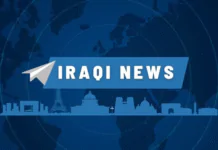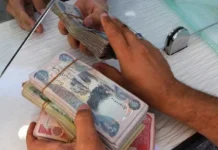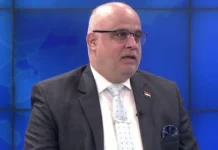Henig: Vietnam tops Southeast Asia in gold consumption with 55 tons annually
By Anh Tu October 31, 2025 | 01:50 am PT
Vietnam leads Southeast Asia in gold consumption, reaching 55 tons a year, according to World Gold Council data cited by a Vietnamese lawmaker.
Thach Phuoc Binh, a member from the southern province of Vinh Long, said at a National Assembly meeting Thursday that the country’s gold consumption of 55 tons last year exceeded that of Thailand (48.8 tons) and Indonesia (47.3 tons).
It was for a third year in a row that Vietnamese consumers had bought more than 55 tons, according to the World Gold Council. The figure comprises jewelry, bars and coins.
But most of the gold remains in people’s safes, a huge resource that has not been converted into capital to fund economic expansion, Binh said.
Gold is typically more expensive in Vietnam than elsewhere, with the gap occasionally widening to VND20 million (US$760) per tael this year.
Binh said the root cause for this is the lack of a transparent, modern and safe gold market for investors.
In the event, he proposed setting up a national gold exchange where people can deposit physical gold in vaults and get electronic certificates for them that could be trading.
With the exchange, other investment products could also be developed such as gold investment funds and gold-backed bonds, he said.
People could benefit from gold price gains while also enabling idle capital to be used.
“If we can bring 10-15% of the gold people possess into the financial system, it will be a precious source of funding for infrastructure, digital transformation and technological innovation and preclude the need to increase public debt.”
Domestic gold prices have repeatedly set new records this year, prompting people to queue for hours to buy the precious metal amid low supply.
Bullion trades at VND148.9 million per tael at the time of publishing, a 77% rise since the start of the year.
The legal framework required for establishing a gold exchange is being studied by the State Bank of Vietnam, Deputy Prime Minister Le Thanh Long said.
“This new model will transparentize transactions, and will hopefully help control the market.”
************
Henig: Remember when we talked about the financial center in Viet Nam? One branch in Ho Chi Minh City, and one in Da Nang? VOILA. Here ya’ go, fam. This acceleration is YUGE.
PM orders int’l financial centre become operational this November
November 01, 2025 – 17:12
Concluding a conference on the establishment of the International Financial Centre (IFC) in Việt Nam on November 1, Prime Minister Phạm Minh Chính underscored that despite challenges, efforts must be accelerated to ensure the centre is up and running this November.
PM Phạm Minh Chính (centre) chairs the conference on the establishment of the International Financial Centre (IFC) in Vietnam on November 1. VNA/VNS Photo
HÀ NỘI — Prime Minister Phạm Minh Chính called for accelerated efforts, despite challenges, to ensure that the International Financial Center (IFC) in Việt Nam becomes operational this November.
He made the requirement while concluding a conference on the establishment of the IFC held on Saturday. In line with the Party Central Committee and Politburo’s directives and a resolution of the National Assembly, the Government plans to set up an IFC in Hồ Chí Minh City and Đà Nẵng. The branch in HCM City will cover about 899ha, and the one in Đà Nẵng about 300ha.
The PM stated that establishing an IFC is a new and difficult task, but it must be accomplished. He stressed the need for strong determination, great effort, and decisive action—avoiding both perfectionism and haste, yet seizing every opportunity—with a commitment to completing each task thoroughly and deliver tangible results.
He noted that the IFC establishment should draw on the experience of 20 others around the world, while also capitalising on the country’s creativity, historical and cultural strengths, and specific conditions.
He asked for close coordination with both domestic and international partners, between financial institutions and Việt Nam’s State agencies; integrating finance with production, trade, and investment; combining internal and external strengths; and adhering to international law and practices applied flexibly and creatively in Việt Nam’s context.
The Government leader clarified that Việt Nam’s IFC has a steering committee chaired by the PM, two governing boards at the two locations, one supervisory body, and a court to resolve disputes in both places. The centre will operate on a digital basis and utilise artificial intelligence (AI) to enhance competitiveness and attract resources.
The centre should attract top domestic and international talent, provide a supportive and harmonious living environment with access to education, health care, and culture, blend tradition with innovation, and ensure close coordination among banking – financial institutions and other agencies, he stressed.
The PM said that financial and non-financial services there, as well as licensing and registration, should be flexible and favour post-approval supervision over pre-approval examination. The legal framework should be transparent and autonomous, separating domestic and international operations, with certain incentives and mechanisms.
Highlighting the importance of technology transfer, PM Chính stressed that Việt Nam’s IFC should not create barriers against other centres or among participants within and outside the centre. It should extend beyond finance to production, business, trade, and investment; stay globally competitive; and streamline all administrative procedures through a single-window system.
He asked authorities of HCM City and Đà Nẵng to prepare infrastructure, conditions, and policies to ensure the IFC becomes operational in November 2025.
To do that, attention should be paid to applying science, technology, and innovation, and encouraging bold mindset and decisive action, he said, noting that resources come from vision and mindset, motivation stems from innovation and creativity, and strength derives from the people and businesses.
Delegates shared insights and proposed mechanisms, policies, and measures to ensure the centre’s early launch and efficient operation, including the legal status of its governing and supervisory bodies, operational and risk management mechanisms, product frameworks, trading market and infrastructure, and measures for attracting resources to the centre.
To delegates’ proposals, the PM tasked the Ministry of Finance and relevant agencies to review feedback and urgently finalise policies and the draft decree for the Government’s approval, ensuring the centre comes into operation this November. — VNA/VNS
https://vietnamnews.vn/economy…..ember.html
Henig: FTA ecosystem: foundation to better leverage tariff preferences
November 03, 2025 – 22:55
The FTA ecosystem is seen as a strategic step to implement the Government’s directive on enhancing the country’s integration capacity and accelerating trade and economic growth.
Tra fish processed for export. Developing an FTA ecosystem is a strategic move to strengthen integration capacity and create momentum for trade and economic growth. — VNA/VNS Photo Vũ Sinh
HÀ NỘI — Việt Nam is developing a comprehensive free trade agreement (FTA) ecosystem to create a foundation to help domestic producers and exporters better leverage tariff preferences and strengthen competitiveness in the global market,
A workshop in Hà Nội was told on Monday. The FTA ecosystem is seen as a strategic step to implement the Government’s directive on enhancing the country’s integration capacity and accelerating trade and economic growth.
Deputy Minister Nguyễn Sinh Nhật Tân said at the consultation workshop held by the ministry to draw contributions to the development of the FTA ecosystem, that to date, Việt Nam has signed 17 FTAs with more than 63 partners, including new-generation FTAs such as the EU–Việt Nam Free Trade Agreement (EVFTA), the UK–Việt Nam Free Trade Agreement (UKVFTA) and the Comprehensive and Progressive Agreement for Trans-Pacific Partnership (CPTPP).
Vietnamese enterprises have significantly benefited from the FTAs, as reflected in increases in trade, investment, and development cooperation, Tân said, adding that the FTAs also create favourable conditions for Vietnamese firms to participate deeply in the global supply chain.
Still, Vietnamese firms, especially small and medium–sized enterprises (SMEs), continue to face challenges in taking full advantage of the opportunities arising from the FTAs, Tân said. “Developing an FTA ecosystem is therefore a strategic move to strengthen integration capacity and create momentum for trade and economic growth,” he said.
According to Ngô Chung Khanh, deputy director of the ministry’s Multilateral Trade Policy Department, domestic enterprises still face substantial challenges in utilising FTA benefits, including a lack of information on import markets, standards and customers, and difficulty in meeting import requirements such as rules of origin, technical standards and sustainability criteria. In addition, domestic enterprises also encounter limited access to capital and technology, with most being of small and medium sizes, weak branding capacity and weak linkage among enterprises, localities and government agencies.
Because these problems exist across the entire value chain, Việt Nam needs an ecosystem that connects all relevant stakeholders to make the most of FTAs’ advantages, improve competitiveness and accelerate public–private partnership, Khanh said. The proposed FTA ecosystem model will function as a comprehensive network connecting parties involved in the value chain, from producers, processors, distributors, logistics operators, associations, financial institutions and Government agencies.
The model aims to create a culture of connectivity, information sharing and mutual support to enable enterprises to optimise FTA benefits.
Khanh said the ecosystem is expected to generate significant economic impacts for Việt Nam, especially in expanding and diversifying export markets, attracting foreign investment, improving productivity and accelerating the shift toward a green and sustainable growth model.
The ecosystem would first reinforce Việt Nam’s policy framework for FTA implementation by strengthening the Government’s role in coordinating trade policy and managing resources to help enterprises make the most of tariff preferences, Khanh said.
For farmers, participating in the FTA ecosystem would help them access credit and technical support to meet export standards. For enterprises, the ecosystem would improve access to capital and trade intelligence, including market data and customer connections.
Khanh, however, emphasised that the ecosystem will only operate efficiently if participants share a common vision and production mindset. The ecosystem is open, but not to everyone, as each participant must meet specific criteria, such as a commitment to sustainable development. “The FTA ecosystem is expected to help Việt Nam not only make better use of FTAs but also lay the foundation for long-term and sustainable economic development,” Khanh said.
Mạc Quốc Anh, Deputy President of the Hà Nội Association of Small and Medium-Sized Enterprises (HANOISME), called for the early establishment of an FTA centre in Hà Nội to serve as a bridge providing consultancies on FTAs and rules of origin. He stressed that the centre would provide timely updates of FTAs so that the ratio of enterprises which could utilise tariff preferences under the FTAs would increase from the current 32 per cent to 55 per cent by 2026.
In addition, it is necessary to speed up the digitalisation of the certificate of origin (C/O) issuance process to cut processing time by 50 per cent and ensure all applications are processed only and eliminate paper documentation by 2026.
Việt Nam also needs to develop an FTA capacity index to assess enterprises’ capacity of access to preferential tariffs, origin management, logistics capacity and green transition.
According to Associate Professor Đào Ngọc Tiến, Vice Principal of the Foreign Trade University, once operational, the ecosystem would have a significant impact on economic growth.
Specifically, Việt Nam’s GDP growth could be 1.65 percentage points higher in 2025 compared to the baseline and remains above the trend by 2030, with export-oriented services and industrial sectors expected to be the main drivers, he said.
The FTA ecosystem would also help accelerate economic restructuring and boost Việt Nam’s trade performance with an improving trade balance, he said. MOU signing
At the workshop, Việt Nam’s Ministry of Industry and Trade and the Department of Foreign Affairs and Trade of Australia signed a memorandum of understanding on cooperation to optimise FTAs’ benefits.
Australian Ambassador to Việt Nam Gillian Bird highly appreciated Việt Nam’s impressive economic growth, adding that the Australian Government has been working to support enterprises to utilise FTAs in which both Australia and Việt Nam are members, including CPTPP, the Regional Comprehensive Economic Partnership (RCEP) and the ASEAN – Australia – New Zealand FTA.
The MOU signing represents an important step in strengthening the relationship between Việt Nam and Australia and lays the foundation for a more favourable business environment, and contributes to addressing global challenges.
The MOU not only promotes bilateral trade but also helps farmers and businesses to expand global reach and pursue sustainable growth, she stressed.
According to Tân, the signing marked a significant milestone in cooperation between the two ministries and countries towards unlocking the full potential of FTAs and realising the comprehensive strategic partnership between the two countries. — VNS
*****************
Henig: IMO: A “leisure airline”? At 26,312 VND to the Dollar? Interesting.
Vietnam’s first leisure airline Sun PhuQuoc Airways launches commercial flights
ByGoda Labanauskaite November 3, 2025,
Sun PhuQuoc Airways New Vietnamese carrier Sun PhuQuoc Airways has officially launched commercial flight operations, becoming the country’s first leisure airline.
In a statement on November 1, 2025, Sun PhuQuoc Airways announced that it will begin operating three domestic routes – Phu Quoc to Hanoi, Phu Quoc to Ho Chi Minh City, and Hanoi to Ho Chi Minh City – starting right away and continuing until the end of 2025.
The airline said that the introduction of these flights comes at a “crucial time”, as the airline prepares to help accommodate the rising travel demand during Phu Quoc’s busy tourism season and the upcoming Lunar New Year 2026.
“This is not only the beginning of a new airline, but also the start of a new approach – where aviation and tourism go hand in hand to deliver distinctive travel experiences,” Nguyen Manh Quan, the CEO of Sun PhuQuoc Airways.
Inaugural flight celebrations
Sun PhuQuoc Airways was established six months ago in May 2025 by the Sun Group, a Vietnamese economic organization.
The airline launched its inaugural commercial flight from Vietnam’s capital city Hanoi to Phu Quoc, Vietnam’s largest island, in the early morning on November 1, 2025. Flight 9G1203 took off from Noi Bai International Airport (HAN), carrying 220 passengers on an Airbus A321.
Shortly after, two more flights left for Phu Quoc: one from Ho Chi Minh City and another from Da Nang. All three flights marked the airline’s initial day of commercial service to the Vietnamese island.
The Da Nang-Phu Quoc route was operated as a special celebratory flight marking the airline’s inauguration, with regular service set to begin in March 2026.
On its first day of operations, the airline said that every boarding pass was marked with the phrase “First Flight – 1.11.2025”, and each passenger seat included a specially designed souvenir set featuring Sun PhuQuoc Airways’ signature Sun symbol
Where will the airline fly next?
Starting in early 2026, the airline intends to broaden its network and increase the number of flights, with regular routes connecting Da Nang-Phu Quoc and Nha Trang-Phu Quoc set to launch in March 2026.
Additionally, in the same year, Sun PhuQuoc Airways said it plans to start direct international flights from Phu Quoc to South Korea, Taiwan, Thailand, Singapore, Hong Kong, and India.
According to its official website, Sun PhuQuoc Airways intends to operate six aircraft by 2026, with a total investment of VND 2.5 trillion (US $100 million). The airline’s goal is to expand its route network by 200% and serve 10 international destinations by 2026.
https://www.aerotime.aero/articles/new-carrier-sun-phuquoc-airways-launches-commercial-flights
Billionaire Pham Nhat Vuong’s VinSpeed seeks to build $5.3B Hanoi-Ha Long Bay rail link
By Anh Tu November 3, 2025 | 12:39 am PT
VinSpeed wants to build a Hanoi-Ha Long Bay high-speed rail at a cost of VND138.93 trillion (US$5.3 billion) and begin operating it by 2028.
If the project is approved this quarter construction would begin immediately and be completed by the last quarter of 2027 for testing and commercial launch by the first quarter of 2028, VinSpeed said in a recent filing with the government.
The 120-kilometer line will start at the National Exhibition and Convention Center in Hanoi, pass through Bac Ninh Province and Hai Phong City and end at Tuan Chau Ward in Ha Long.
It will have a maximum speed of 350 kilometers per hour. In the early years of operation VinSpeed expects to run a train every 60 minutes, and every 30 minutes from 2030.
The project has been added to the government’s nationwide rail network planning for the period until 2030, but a developer has not been selected.
Another key project the company plans is the high-speed line between Hanoi and HCMC spanning 1,541 kilometers.
It has applied to build the railroad at a cost of $61.35 billion, equivalent to 13% of Vietnam’s GDP.
VinSpeed, founded by Vietnam’s richest man Pham Nhat Vuong in May, operates in railroad construction and rolling stock manufacturing.
Vuong owns 51% of the company and the rest is owned mostly by Vuong-controlled Vietnam Investment Group (35%) and his flagship company Vingroup (10%).
****************
Henig: IMO: Vietnam becoming a target for sovereign wealth funds? Interesting. I’m definitely paying attention now.
Vietnamese market in the ‘sights’ of the Gulf capital flows
October 31, 2025 – 16:00
In the context of global capital flows shifting strongly, Việt Nam has emerged as a strategic destination for sovereign wealth funds due to its stable economic growth, open business environment, and clear sustainable development orientation.
Strong capital shifts According to estimates by Deloitte, the total asset value of sovereign wealth funds reached $12 trillion by the end of last year and is projected to hit $18 trillion over the next five years. Gulf countries (including Bahrain, Kuwait, Oman, Qatar, Saudi Arabia, and the UAE) account for about 40 per cent of this, while possessing six of the world’s ten largest investment funds.
These funds primarily operate with a dual objective: increasing asset value and supporting sustainable global development strategies. This creates a major distinction from private equity funds. The first is their risk appetite. A common trait of Gulf sovereign wealth funds is a relatively low risk appetite and a long-term vision, allowing them to accompany invested businesses for decades, enabling companies to focus on long-term development plans rather than chasing short-term profits.
Second, Gulf sovereign wealth funds often bring high levels of stability and reliability. Their presence typically creates a positive spillover effect, attracting capital from other investors. They also provide invested businesses with “privileges” in global networks, market expansion opportunities, and technology transfer.
Despite numerous economic and geopolitical fluctuations, the capital scale and disbursement pace of these Gulf “sharks” show no signs of slowing.
They disbursed $55 billion in the first nine months of last year, equivalent to two-thirds of new investment activities by sovereign wealth funds globally. However, this group’s capital flows are shifting strongly, both in terms of destinations and investment sectors.
Previously active investors in the U.S. tech market with billion-dollar deals, they are now gradually turning their attention to regions with lower geopolitical risks, such as South Asia and Southeast Asia. This group is particularly interested in flexible macroeconomic policies and economic openness through signed free trade agreements.
With all these factors in place, plus numerous policies attracting investment in science and technology, innovation, and green growth to serve national development goals, Việt Nam has become a potential destination for Gulf investment funds. Some funds have poured hundreds of millions of USD into the country while continuing to seek two-way cooperation opportunities with domestic businesses.
A model ‘magnet’ for attracting Gulf capital The Vietnam Oman Investment (VOI) is a prime example of a channel for Gulf capital into Việt Nam. Since its establishment in 2008, the fund has disbursed approximately $500 million into key Vietnamese sectors such as healthcare, education, clean water, renewable energy, agriculture, food, infrastructure, bridges, and roads. Projects in which VOI has invested, such as the Rach Mieu 1 Bridge, Rach Mieu 2 Bridge, Song Hau Water Company, BCG Long An 1 and BCG Long An 2 solar power projects, and Hanh Phuc General Hospital in An Giang Province, have contributed immensely to upgrading infrastructure, ensuring energy security, and improving social welfare for communities.
In the financial sector, VOI has also created positive impacts, with a $30 million investment in F88 that helped the business expand its network, digitise, and improve risk management before listing on the stock exchange earlier this year. Most recently, VOI participated in the initial public offering (IPO) of Techcom Securities (TCBS), contributing to Việt Nam’s tokenised asset development strategy.
As the intergovernmental fund, VOI also serves as a bridge helping Vietnamese goods penetrate the Gulf market, and vice versa, opening opportunities for Omani businesses to strengthen their presence in Southeast Asia.
VOI’s success has laid the foundation for the two countries’ investment agencies to agree on establishing the “Việt Nam New Era Growth Fund” with a minimum capital of $200 million, marking the beginning of a deeper cooperation phase.
“VOI has played the role of a collective capital conduit, attracting other Gulf funds to Việt Nam. This is not only economic investment but also contributes to promoting social development, improving people’s lives, and reinforcing Việt Nam’s image as a safe and attractive destination.
We strive to become an effective bilateral bridge for the two governments, indirectly elevating Việt Nam-Oman relations to new heights and expanding to the entire Gulf region,” a fund representative shared. At the Political Consultation meeting at the end of September, diplomatic representatives from both countries agreed that Việt Nam and Oman share many similarities, their economies complement each other, and there is ample room to develop multifaceted cooperation.
Omani Deputy Foreign Minister Khalifa Bin Ali Al Harthy reaffirmed that Việt Nam is a dynamic economy, politically stable, fast-growing, and highly promising in the Asia-Pacific. Oman views Việt Nam as an important partner in its “Look East” policy.
This, combined with policies attracting international investors into key national projects on technology infrastructure and international financial centres, is expected to become a “magnet” drawing capital from Oman and other Gulf countries to Việt Nam.
According to a VOI representative, sovereign wealth funds always have strict investment standards and due diligence processes based on pre-determined risk appetites. With priorities in seeking stable and sustainable returns for both themselves and the recipient, they often look for leading enterprises with healthy competitive advantages and high governance standards.
“Việt Nam possesses many long-term growth drivers, but risks are higher compared to developed markets. Therefore, governance thinking and risk mitigation play a special role in investment due diligence. To access capital from Gulf ‘sharks,’ Vietnamese enterprises need to demonstrate transparency and meet international standards in finance, auditing, and risk management.
These factors will help build trust with the investment funds while reducing risks for the enterprise’s own operations,” the VOI representative recommended. Gulf sovereign wealth funds are also pursuing investment strategies tied to sustainable development.
Therefore, enterprises integrating ESG (environment, social, and governance) pillars into business strategy and operations will create alignment with partner priorities. Beyond creating financial value, Vietnamese enterprises can increase their appeal to sovereign wealth funds by acting as bridges and distribution channels to pave the way for their goods and services into Southeast Asia. According to the VOI representative, this is currently an advantage but will gradually become a prerequisite for entering the portfolios of Gulf investment funds./.






